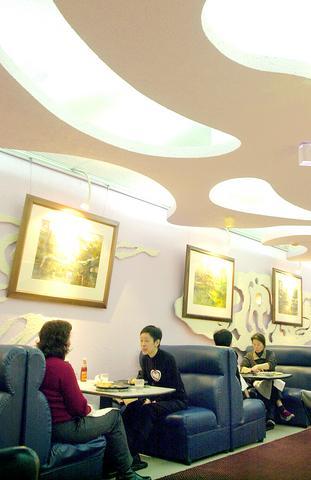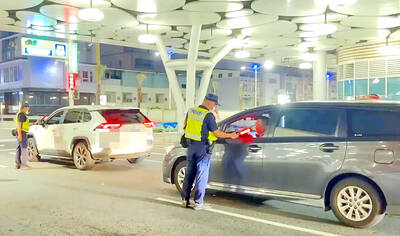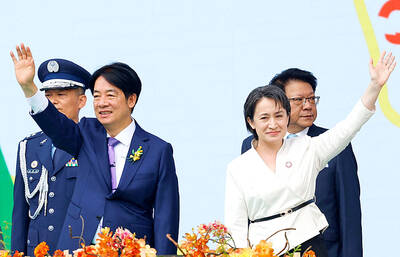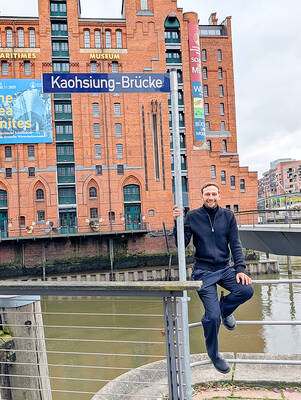Near the intersection of Taipei's Yenping North Road and Minsheng West Road, Bolero restaurant is a reflection of the once-vibrant Tataocheng (
Bolero enjoys a huge reputation; when Taipei residents are asked about the restaurant, most have heard of it and some remember it as a matchmaking hub.
But like the character Norma Desmond in Sunset Boulevard, Bolero and Tataocheng's heydays have passed.

PHOTO: CHIANG YING-YING, TAIPEI TIMES
The Bolero restaurant opened in 1934, and it was the top western-style diner in the 1950s and 1960s. But no one would recommend it as a top-class place to go anymore, although the restaurant still does good business.
"Twenty-five years ago, Bolero was still the leading restaurant in Taipei, doing even better than five-star hotels. There was no competition," restaurant manager Liao Tsung-chi (廖聰麒), who has worked there since 1967, said proudly.
"Bolero was not a restaurant for ordinary folks because of the prices, and people who came were always well-dressed and talked in low voices. Restaurants in major hotels would also send their people to us to learn about the business," he said.
Liao said that the restaurant used to host top businessmen, such as Formosa Plastics Group chairman Wang Yung-ching (王永慶).
"He doesn't come here anymore since it's difficult for a famous person to show up in a public place and not be recognized and bothered by others. But his third wife still dines here every now and then," Liao said.
Shipping tycoon Chang Yung-fa (
Even the so-called tang wai ("outside the party,"
Liao said that Huang Hsin-chieh (
"But of course these days young people have other choices, and the restaurant has become more a place for reminiscing," Liao said.
Indeed, with its slightly weathered exterior, plain white-and-blue billboard and unstylish blue sofa, Bolero has no visible glam to attract the young anymore.
Liao said that the restaurant now mostly hosts regular customers, and these customers often bring their relations.
"Now whenever I go to the restaurant, it's more for a taste of the past," said Yiu Chi-cheng (
Originally there was only one Bolero, but founder Liao Shui-lai (
"But both Boleros are well-known restaurants and popular matchmaking places," Yiu said.
And it is not just the restaurant that has a long history, its employees do too. Liao has worked there for more than 30 years, and 25-year-old waiter Lin Po-chi (
"Business is not as good as before with the economy slowing in recent years," Lin said.
Liao said that his experience in the restaurant proved to him the validity of the Taiwanese proverb, "Wealth can last no more than three generations."
"Sometimes I would see that certain customers or their descendents stop coming because they cannot afford to dine here any-more," Liao said.
Buildings similar to the one Bolero occupies are everywhere in the area of Tihua Street, made famous for its candies, snacks and food for the Lunar New Year holidays.
Most buildings are only three or four floors high, and the color of red bricks has faded, the white walls grayed.
Yet many buildings are also adorned with delicate engravings that cannot be seen on more modern constructions.
Tihua Street and Yenping North Road are a part of Tataocheng, a huge area along Tamshui River to the northwest of Taipei Main Station.
Tataocheng used to be Taipei's economic center before Japan's defeat in World War II, but now it is considered part of old Taipei.
Many famous local entrepre-neurs based their businesses in that area. Both Straits Exchange Foundation Chairman Koo Chen-fu's (辜振甫) father, Koo Hsien-jung (辜顯榮), and Shinkong (新光) Group founder Wu Ho-shih (吳火獅) were respected tea merchants, while China Development chairwoman Diana Chen's (陳敏薰) family was in the textile business in the area.
"Tataocheng is a noble part of the past," said Tu Nien-ru (杜念魯), a 30-year-old Taipei resident. "But then again, Tihua Street is probably the only place in Taipei that can allow people to celebrate the Lunar New Year properly with its New Year goodies.
"The glory may be gone, but the area is a cultural treasure," Tu said.
"When you walk around that area, you do get the feeling of a rich tradition," he said.

TRAFFIC SAFETY RULES: A positive result in a drug test would result in a two-year license suspension for the driver and vehicle, and a fine of up to NT$180,000 The Ministry of Transportation and Communications is to authorize police to conduct roadside saliva tests by the end of the year to deter people from driving while under the influence of narcotics, it said yesterday. The ministry last month unveiled a draft of amended regulations governing traffic safety rules and penalties, which included provisions empowering police to conduct mandatory saliva tests on drivers. While currently rules authorize police to use oral fluid testing kits for signs of drug use, they do not establish penalties for noncompliance or operating procedures for officers to follow, the ministry said. The proposed changes to the regulations require

The Executive Yuan yesterday announced that registration for a one-time universal NT$10,000 cash handout to help people in Taiwan survive US tariffs and inflation would start on Nov. 5, with payouts available as early as Nov. 12. Who is eligible for the handout? Registered Taiwanese nationals are eligible, including those born in Taiwan before April 30 next year with a birth certificate. Non-registered nationals with residence permits, foreign permanent residents and foreign spouses of Taiwanese citizens with residence permits also qualify for the handouts. For people who meet the eligibility requirements, but passed away between yesterday and April 30 next year, surviving family members

Taiwanese officials are courting podcasters and influencers aligned with US President Donald Trump as they grow more worried the US leader could undermine Taiwanese interests in talks with China, people familiar with the matter said. Trump has said Taiwan would likely be on the agenda when he is expected to meet Chinese President Xi Jinping (習近平) next week in a bid to resolve persistent trade tensions. China has asked the White House to officially declare it “opposes” Taiwanese independence, Bloomberg reported last month, a concession that would mark a major diplomatic win for Beijing. President William Lai (賴清德) and his top officials

The German city of Hamburg on Oct. 14 named a bridge “Kaohsiung-Brucke” after the Taiwanese city of Kaohsiung. The footbridge, formerly known as F566, is to the east of the Speicherstadt, the world’s largest warehouse district, and connects the Dar-es-Salaam-Platz to the Brooktorpromenade near the Port of Hamburg on the Elbe River. Timo Fischer, a Free Democratic Party member of the Hamburg-Mitte District Assembly, in May last year proposed the name change with support from members of the Social Democratic Party and the Christian Democratic Union. Kaohsiung and Hamburg in 1999 inked a sister city agreement, but despite more than a quarter-century of